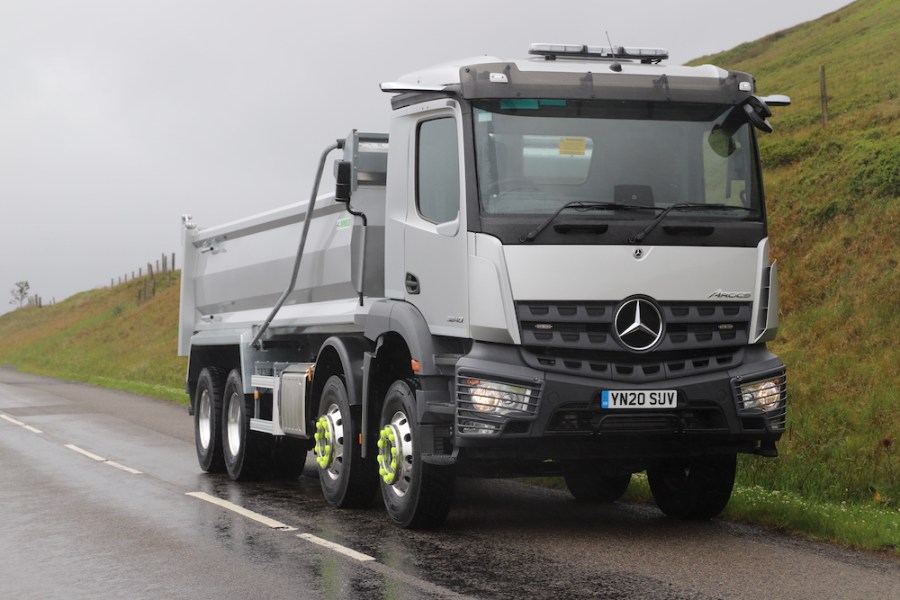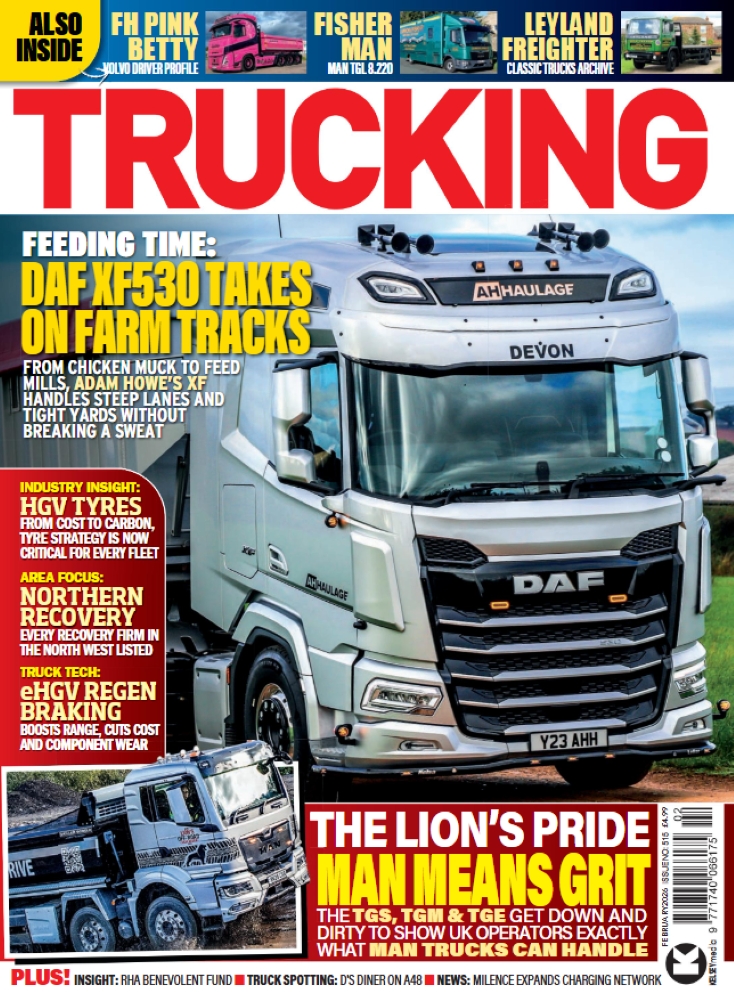MirrorCam and Multimedia Cockpit comes to the tipper range. Trucking takes a Mercedes-Benz Arocs 8×4 to for a drive…
It’s been a few years since Mercedes-Benz launched its new MirrorCam system and its associated Multimedia Cockpit. That launch, of what the German manufacturer was calling the Version 5 of the Actros, was mainly centred on the tractor units. But at the same launch we were told the Antos name was being dropped and that Arocs would also be offered with the new gadgetry.
Since that launch in Berlin in September 2018, we have had our first drives of the new trucks – in Barcelona in May 2019, then the first RHD trucks in the UK in July 2019; and then the first RHD with Active Drive Assist in November. We’ve not been short of time behind the wheel of the big Actros models.
The development of the Arocs with the new features has been slower. And there’s good reason for that. For a start, with so much ‘going on’ in the launch of the new ranges, it’s understandable Merc hasn’t been able to get everything in the shop window straight away. Plus the Arocs range, which is aimed at construction and heavy duty work in the main, is more of a parochial market.
In fact, there’s the question of whether those in the construction market want all these whizzy new features – especially MirrorCam? As with the Version 5, you can opt not to have MirrorCam, and indeed you can forego the new cockpit for the ‘classic’ old-school set up. We wouldn’t recommend you do, but you can.
But now, Merc in the UK has a right-hand drove Arocs 3420K available for testing. And Trucking was the first to get a test drive in under the rules and regulations now in force regarding social distancing as we – hopefully – start to come out the other side of the horrific COVID-19 pandemic.
Technical overview
The truck we had charge of was a 3240K, 8×4 double-drive tipper. The cab was the 2.3 m wide M-cab ClassicSpace with the 320 mm engine tunnel. That’s a day cab, although there is room for a pull-down bunk if you want or need it; but the test truck didn’t. It does give you some decent room behind the seats to store bags and other stuff you my need for the working day.
Under the cab is the second-generation OM470 10.7-litre engine with 394 bhp output, delivering 1900 Nm of torque. Other options are 428 bhp and 459 bhp in this lump, plus the 12.8-lite engine is also available at 428, 449 and 476 bhp. Some may feel 394 bhp is a little too underpowered, but it’s pretty much par for the course for an eight-legger these days. It’s main rivals are the Volvo FMX410, DAF CF410, Scania G410XT, MAN TGS 35.400, Iveco X-WAY and Renault Range K430.
The gearbox is the second-generation G211-12 PowerShift 3, which is a 12-speed automated manual. The rear axle ratio is 3.308:1. The axle ratings are 7100 kg on both the front steer axles, and 9500 kg on each are axle. The truck is plated at 32,000 kg, although you can tag a drawbar on it and work at up to 44,000 kg. That said, if you do regularly pull a trailer, then you’ll probably want to look at a bigger engine, possibly 3248.
The wheelbase is 5150 mm, which is fairly typical spec for a muckaway tipper these days. With a 290-litre fuel tank and a 25-litre AdBlue tank, the chassis cab tipped the scales at 9585 kg – before the 15 m3 Boweld Taperlite body and Edbro XX15 tipping gear is added.
In the cab
Some might argue that once you’ve driven the new Mercs a few times, they might possibly start to lose their novelty. We wouldn’t say that is the case. The set-up remains excellent, although honestly we still have a few reservations about using touch screens while driving.
However, remember we only drive these trucks very occasionally, and once you have got behind the wheel of one of these cab layouts on a regular basis, those reservations might start to drift away as you become familiar with the buttons and screens.
MirrorCam is excellent. We are big fans, but its advantages certainly become more obvious on an artic with a trailer behind you. On a rigid, the system is pretty similar to conventional mirrors. It’s not perfect – indeed, we had to clean the camera once while on the move due to a mark on it affecting the view.
But we still think it’s pretty good. And for those doubting its applications on a tipper, we’d say it still has many advantages, especially on building sites and close to fork-lifts and cranes. There’s also the fact there is less chance of them being hit or damaged, which is a real plus point.
Put it this way: there is no reason not to have MirrorCam on a tipper. It need not be the sole preserve of artic drivers.
The truck has the 12 inch instrument panel and touch screen displays. There were all the features of the big trucks – Apple CarPlay, wireless charging tray, keyless go with remote central locking, and an electronic handbrake. It also had a useful reversing camera.
On the road
Sadly, due to the COVID-19 pandemic that has closed or affected so many businesses, we were not able to have a load on board. So even over a demanding Pennine route, the truck flew a bit. We headed across the Woodhead Pass and then turned right to head to Dunford Bridge. Our planned photo call at the car park next to the old station was instantly canned when we found it was being ripped up for resurfacing, so we headed down to Winscar Reservoir for a few images.
One thing that was instantly noticeable is how well the truck handled the road, and how enjoyable it was to drive. The steering was lively and light. It’s not quite as light as Volvo’s Dynamic Steering, but it’s not far behind. Either way, it’s easy to handle. The turning circle is also very good for an eight-wheeler – which by design are not the easiest things to turn around!
After we’d passed a 44-tonner coming the other way, the Merc flew up the hill away from Dunford Bridge. But with 20-odd tonnes in the back, we reckon it would have been working hard. If this kind of terrain is part of your regular remit, then we’d suggest the 3243 or 3246 options.
After the photo stop, we carried on and dripped down into Holmfirth. This is where the three-stage engine brake got a good workout – and it was very impressive; better than, say, a Scania or a Renault.
Once into the town centre, there is an awkward right turn on a hill, with traffic lights at the top. Here we were able to exploit a brilliant feature on the Arocs: the hill hold. You don’t need to put it in neutral, then operate the brake; merely depress the brake pedal fully until the HOLD light comes on on the screen. Then when the lights change, simply accelerate and you are off and away.
After negotiating Holmfirth, we headed into Huddersfield for a bit of town driving, and here again the hill hold came into its own. There are some vicious hills in the town and stop-start traffic means there’s plenty of time to use both the engine brake and the hill hold. Both features make the drive so much more pleasurable.
Having negotiated Huddersfield, we headed onto the M62 for some motorway driving, which the truck coped with admirably. We were planning to head straight onto the M1, but a diversion saw us head through Wakefield, which was not great shakes as again it allowed more town driving.
Verdict
Go back 35 years and Merc was late to the eight-wheeler party. Back then, it offered just the gutless 3025 – and that was it until the late 1980s when the equally gutless 3229 appeared. It wasn’t until the 1990s that Merc started to take this market sector seriously in the UK.
Now it does, and does some! There’s a great range of engines and outputs. There are day, sleeper and high-roof sleeper options. There are Actros and the heavy-duty Arocs chassis. In short, the days of ‘one choice and that’s it’ are long gone. Merc now has the right eight-wheeler for all applications.
Any reservations about spec’ing MirrorCam and Multimedia Cockpit on an Arocs are easily disproved. It’s fine for this the of truck, and we would say just having camera arms and not full mirrors should lead to less risk of damage on what can be demanding work.
The Arocs has always been a competent piece of kit. With the smaller cab, it affords extra payload, plus is also easier to get in and out of with its three-step access. It’s nice and easy to drive, and it handles well on the road.






